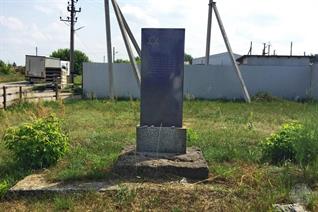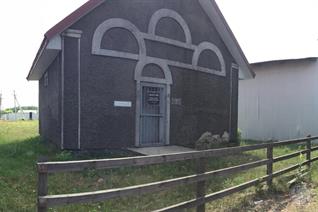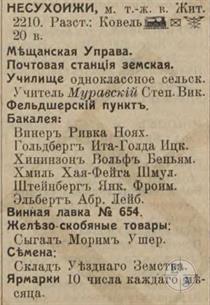Toykut (Nesukhoizhy)
Kamin-Kashyrskyy district, Volyn region
Sources:
- Yad Vashem. Niesuchojeze
- European Jewish Cemeteries Initiative. Toykut Jewish Cemetery
- The All South-Western Territory: reference and address book of the Kyiv, Podolsk and Volyn provinces. Printing house L.M. Fish and P.E. Wolfson, 1913;
- Gal Einai. Rabbi Mordechai of Neskhizh: Resurrecting the Dead
Photo:
- European Jewish Cemeteries Initiative. Published by Center for Jewish Art, Toykut
- Yad Vashem. Niesuchojeze
- European Jewish Cemeteries Initiative. Toykut Jewish Cemetery
- The All South-Western Territory: reference and address book of the Kyiv, Podolsk and Volyn provinces. Printing house L.M. Fish and P.E. Wolfson, 1913;
- Gal Einai. Rabbi Mordechai of Neskhizh: Resurrecting the Dead
Photo:
- European Jewish Cemeteries Initiative. Published by Center for Jewish Art, Toykut
 |
 |
| Mass grave of the victims of Holocaust on the site of the Jewish cemetery, 2019 | Ohel of Rabbi Mordechai Shapira of Neskhizh, 2019 |
The former township of Nesukhoizhy (now village of Toykut) was the center of one of the branches of the princes Sangushko.
The first mention of the Jews of Neskhizh (Toykut’s Yiddish name) dates to 1569.
Since the mid-18th century, the Jewish community was represented by the Shapira branch of the Hasidic dynasty.
In 1847, the Neskhizh Jewish community counted 878 individuals.
By 1870, a synagogue had been built.
The 1897 census estimates the town’s Jewish population at 814 (43.7% of the total population).
By 1921, the population had more than halved in size. Although now only 435 Jews lived in Toykut, they made up 92.7% of the total population.
Before the Nazi occupation on June 25, 1941, it is estimated that 520 Jews lived in the village.
The first mention of the Jews of Neskhizh (Toykut’s Yiddish name) dates to 1569.
Since the mid-18th century, the Jewish community was represented by the Shapira branch of the Hasidic dynasty.
In 1847, the Neskhizh Jewish community counted 878 individuals.
By 1870, a synagogue had been built.
The 1897 census estimates the town’s Jewish population at 814 (43.7% of the total population).
By 1921, the population had more than halved in size. Although now only 435 Jews lived in Toykut, they made up 92.7% of the total population.
Before the Nazi occupation on June 25, 1941, it is estimated that 520 Jews lived in the village.
The Germans captured the town on June 26, 1941. Shortly afterwards they established a Judenrat (Jewish council).
All the Jews were ordered to wear an armband with the Star of David. They also had to pay a high ransom and to perform different types of forced labor. A nighttime curfew was imposed as well.
According to one testimony, at the beginning of 1942 25 young Jewish girls were rounded up, stripped naked, and beaten, while some of them were raped as well.
In August 1942 several hundred Jews were taken to open pits in the center of the town (or, according to another testimony, on the outskirts of the town) and shot to death. Several Jews managed to escape and later join the Soviet partisans.
In Nesukhoizhy buried the local tzadik and the miracle worker Rabbi Mordechai Shapira.
Rabbi Mordechai Shapira of Neskhizh was born in 5602 (1842) to his father, Rabbi Dov Ber. He was the pre-eminent student of Rabbi Yechiel Michel of Zlotshov and performed many miracles.
Rabbi Mordechai was the rabbi of a number of towns and was devoted to freeing agunot—women “chained” to their husbands because their whereabouts were unknown, or they refused to grant them a divorce. He was the head of a charity for the land of Israel in Poland. Rabbi Mordechai passed away on the 8th of Nissan, 5660 (1900) at the age of 58 and was laid to rest in Neskhizh.
All the Jews were ordered to wear an armband with the Star of David. They also had to pay a high ransom and to perform different types of forced labor. A nighttime curfew was imposed as well.
According to one testimony, at the beginning of 1942 25 young Jewish girls were rounded up, stripped naked, and beaten, while some of them were raped as well.
In August 1942 several hundred Jews were taken to open pits in the center of the town (or, according to another testimony, on the outskirts of the town) and shot to death. Several Jews managed to escape and later join the Soviet partisans.
In Nesukhoizhy buried the local tzadik and the miracle worker Rabbi Mordechai Shapira.
Rabbi Mordechai Shapira of Neskhizh was born in 5602 (1842) to his father, Rabbi Dov Ber. He was the pre-eminent student of Rabbi Yechiel Michel of Zlotshov and performed many miracles.
Rabbi Mordechai was the rabbi of a number of towns and was devoted to freeing agunot—women “chained” to their husbands because their whereabouts were unknown, or they refused to grant them a divorce. He was the head of a charity for the land of Israel in Poland. Rabbi Mordechai passed away on the 8th of Nissan, 5660 (1900) at the age of 58 and was laid to rest in Neskhizh.

- Home
- Shtetls
- Vinnytsia region
- Volyn region
- Dnipro region
- Donetsk region
- Zhytomyr region
- Zakarpattia region
- Zaporizhzhia region
- Ivano-Frankivsk region
- Kyiv region
- Kropyvnytskyi region
- Luhansk region
- Lviv region
- Mykolayiv region
- Odessa region
- Poltava region
- Rivne region
- Sumy region
- Ternopil region
- Kharkiv region
- Kherson region
- Khmelnytskyi region
- Chernihiv region
- Chernivtsi region
- Cherkasy region
- Crimea
- Synagogues
- Cemeteries
- Objects & guides
- Old photos
- History
- Contact
Jewish towns of Ukraine
Jewish towns of Ukraine
My shtetl
My shtetl
Donate
